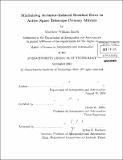| dc.contributor.advisor | David W. Miller. | en_US |
| dc.contributor.author | Smith, Matthew William, Ph. D. Massachusetts Institute of Technology | en_US |
| dc.contributor.other | Massachusetts Institute of Technology. Dept. of Aeronautics and Astronautics. | en_US |
| dc.date.accessioned | 2011-04-25T16:08:03Z | |
| dc.date.available | 2011-04-25T16:08:03Z | |
| dc.date.copyright | 2010 | en_US |
| dc.date.issued | 2010 | en_US |
| dc.identifier.uri | http://hdl.handle.net/1721.1/62492 | |
| dc.description | Thesis (S.M.)--Massachusetts Institute of Technology, Dept. of Aeronautics and Astronautics, 2010. | en_US |
| dc.description | Cataloged from PDF version of thesis. | en_US |
| dc.description | Includes bibliographical references (p. 135-139). | en_US |
| dc.description.abstract | Heritage space telescope mirror technology-i.e. large, monolithic glass primary mirrors-has reached an upper limit on allowable aperture diameter given launch vehicle volume and mass constraints. The next generation of space telescopes will feature lightweight, actively controlled, segmented primary mirrors in order to achieve the advances in angular resolution and sensitivity that larger aperture diameters permit. Active control via embedded surface-parallel electrostrictive actuators provides the capability to change a mirror segment's optical prescription on orbit, to correct either quasi-static disturbances or manufacturing errors. Commanding low-order prescription changes (e.g. radius of curvature) using discretely-placed actuators, however, induces high spatial frequency residual error in the mirror surface figure, resulting in wavefront error (WFE) that degrades optical performance. A key challenge is reducing this actuator-induced high frequency WFE to below acceptable levels while simultaneously commanding a particular change in global shape. This thesis considers a new set of geometric design variables that affect high-spatial frequency residual error in an effort to mitigate actuator-induced WFE. Specifically, less conventional variations in rib height, actuator geometry, and rib-to-facesheet intersection geometry are exploited to achieve improved performance in silicon carbide (SiC) mirrors. A parametric finite element model is used to explore the trade space among these new parameters and to predict performance improvements. Simulation results show that these additional geometric considerations reduce actuator-induced WFE while keeping mirror mass and complexity constant. | en_US |
| dc.description.statementofresponsibility | by Matthew William Smith. | en_US |
| dc.format.extent | 139 p. | en_US |
| dc.language.iso | eng | en_US |
| dc.publisher | Massachusetts Institute of Technology | en_US |
| dc.rights | M.I.T. theses are protected by
copyright. They may be viewed from this source for any purpose, but
reproduction or distribution in any format is prohibited without written
permission. See provided URL for inquiries about permission. | en_US |
| dc.rights.uri | http://dspace.mit.edu/handle/1721.1/7582 | en_US |
| dc.subject | Aeronautics and Astronautics. | en_US |
| dc.title | Minimizing actuator-induced residual error in active space telescope primary mirrors | en_US |
| dc.type | Thesis | en_US |
| dc.description.degree | S.M. | en_US |
| dc.contributor.department | Massachusetts Institute of Technology. Department of Aeronautics and Astronautics | |
| dc.identifier.oclc | 712082572 | en_US |
